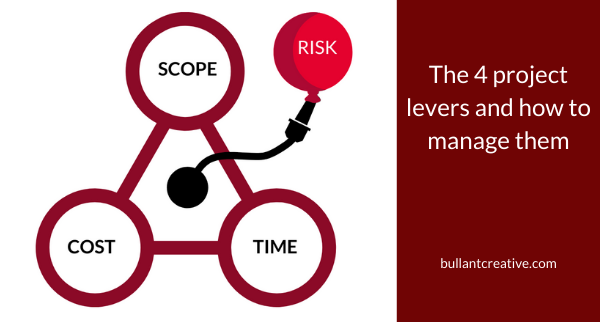It was a cold and miserable winter day on-site at a client’s facility in Victoria, Australia. I was staring at the consequence of a design mistake that I’d made. There was no going back, and I needed to fall on my sword and suffer the consequences.
I remember standing there for a long time, trying to figure out how I’d landed in this position.
In the end, I realised that I had made a fundamental mistake; I’d failed to manage and communicate the 4 levers of project management.
1 – Scope
This project had started with a top-line scope.
There was no detail, not even a spreadsheet.
This is when clients call us, so this wasn’t unusual.
Coping with ambiguity is our stock in trade.
In this type of job, the design process commences straight away. The challenge is to take the client’s overall conceptual design and adjust it to a Minimum Viable Project (MVP) that makes for a robust business case.
This process is exciting, but it is a change process within a change process.
IF the client wants the flexibility to nurture the design, then to do this, we will need to adjust the SCOPE lever. Therefore the other levers will need to be adjusted accordingly.
In this case, I didn’t make the client aware that one lever would affect the other three.
2 – Cost
I haven’t mentioned the word brave yet, and I should have.
Very often, the client has already made a price commitment to the board. The nature of Fast Moving Consumer Goods (FMCG) means that often, there isn’t enough time to work up to total project costs before submission.
Senior managers often view that a business case for, say, a product launch can only sustain a particular capital cost, so this is the top-down figure used for the project submission. Some would call this reckless; I would call it brave and often necessary in dynamic FMCG businesses.
Returning to my problem project, there was no scope, so costs could not be defined during a robust discovery and design process.
Even if we had been able to estimate a cost, it would have had a potential variance of +/- 50% because of the immaturity of the design.
A project with solid design and scope as part of a Minimum Viable Project (MVP) still has a cost exposure of +/- 3-5%.
(A Note: some clients argue that they can get a solid contractual commitment to price and scope that avoids this variance. I would agree with this position but I would also guarantee that the supplier has added the potential cost variance to their proposal)
Mistake 2, I didn’t make the client aware of just how exposed we were to cost variation and that the client may need to adjust the COST lever as the project progressed.
3 – Time
This one is a biggy …… the timing rarely moves.
Nor should it; business plans in the FMCG space are, by definition, time-sensitive.
That said, time costs money. If we have an immovable deadline, we can reduce the scope (remove the extent of work required) or increase costs (add additional resources).
In this case, the deadline for the project meant that crucial process work needed to be completed over the Christmas shutdown.
In hindsight, I should have asked the client if their business had some latitude to adjust this TIME lever, particularly in the context of the situation with the SCOPE and TIME levers.
4 – Risk
So this is where I was as we entered the Christmas shutdown.
- Scope – The scope was ill-defined, and expert resources were unavailable to complete the due diligence against things like the building code.
- Cost – The cost estimates were probably accurate to around +/- 50% at that stage, but the client was becoming increasingly concerned about cost variations, and I didn’t manage the client’s expectations.
- Time – The work needed to be completed during the Christmas shutdown, although this time constraint was never questioned.
So, this was my fatal mistake.
I had seen the basic Scope-Cost-Time project management triad before.
I had never attached a RISK lever as per the graphic.
I had allowed the risk balloon to inflate for several months because I had problems with all of the other levers.
Eventually, the risk balloon burst (straight after Christmas!!), and I was left with a costly design mistake.
The worst part was that I carried the risk without telling the client, yet this was the client’s project, NOT MINE!!
Anyway, I now use the 4 levers to describe the status of projects with clients and then gain agreement.
I also try to view our work together as a collaboration journey as we adjust the levers.
